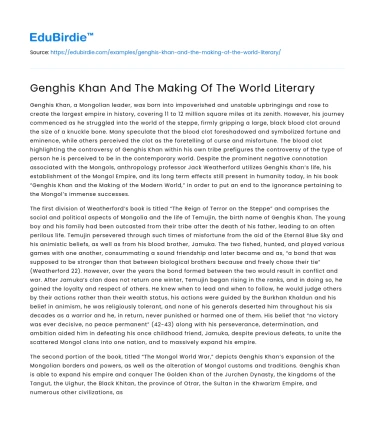Genghis Khan, a Mongolian leader, was born into impoverished and unstable upbringings and rose to create the largest empire in history, covering 11 to 12 million square miles at its zenith. However, his journey commenced as he struggled into the world of the steppe, firmly gripping a large, black blood clot around the size of a knuckle bone. Many speculate that the blood clot foreshadowed and symbolized fortune and eminence, while others perceived the clot as the foretelling of curse and misfortune. The blood clot highlighting the controversy of Genghis Khan within his own tribe prefigures the controversy of the type of person he is perceived to be in the contemporary world. Despite the prominent negative connotation associated with the Mongols, anthropology professor Jack Weatherford utilizes Genghis Khan’s life, his establishment of the Mongol Empire, and its long term effects still present in humanity today, in his book “Genghis Khan and the Making of the Modern World,” in order to put an end to the ignorance pertaining to the Mongol’s immense successes.
The first division of Weatherford’s book is titled “The Reign of Terror on the Steppe” and comprises the social and political aspects of Mongolia and the life of Temujin, the birth name of Genghis Khan. The young boy and his family had been outcasted from their tribe after the death of his father, leading to an often perilous life. Temujin persevered through such times of misfortune from the aid of the Eternal Blue Sky and his animistic beliefs, as well as from his blood brother, Jamuka. The two fished, hunted, and played various games with one another, consummating a sound friendship and later became and as, “a bond that was supposed to be stronger than that between biological brothers because and freely chose their tie” (Weatherford 22). However, over the years the bond formed between the two would result in conflict and war. After Jamuka’s clan does not return one winter, Temujin began rising in the ranks, and in doing so, he gained the loyalty and respect of others. He knew when to lead and when to follow, he would judge others by their actions rather than their wealth status, his actions were guided by the Burkhan Khaldun and his belief in animism, he was religiously tolerant, and none of his generals deserted him throughout his six decades as a warrior and he, in return, never punished or harmed one of them. His belief that “no victory was ever decisive, no peace permanent” (42-43) along with his perseverance, determination, and ambition aided him in defeating his once childhood friend, Jamuka, despite previous defeats, to unite the scattered Mongol clans into one nation, and to massively expand his empire.
Save your time!
We can take care of your essay
- Proper editing and formatting
- Free revision, title page, and bibliography
- Flexible prices and money-back guarantee
The second portion of the book, titled “The Mongol World War,” depicts Genghis Khan’s expansion of the Mongolian borders and powers, as well as the alteration of Mongol customs and traditions. Genghis Khan is able to expand his empire and conquer The Golden Khan of the Jurchen Dynasty, the kingdoms of the Tangut, the Uighur, the Black Khitan, the province of Otrar, the Sultan in the Khwarizm Empire, and numerous other civilizations, as well as the redirecting the Silk Roads, through unique war tactics and strategies. Despite being outnumbered two to one in copious amounts of battles, they seemed to always succeed because before attacking, “they wanted to know everyone in the area, every resource, and they always sought to have a ready path of retreat should it be needed” (Weatherford 86), they were much healthier and stronger than other men due to their protein and calcium-enriched diet, they utilized a decimal organization system for their army in which was uninformed into concentric circles, creating confusion and instilling fear, their goals were centered around winning, and they were cohesive and disciplined from millennia of being nomads.






 Stuck on your essay?
Stuck on your essay?

